Spud’s Quest is an interesting attempt at combining the platformer and adventure game genres, which isn’t all that surprising given that it is heavily influenced by the old Dizzy series, though parts of it feel disjointed. This game is certainly ambitious and there are many parts of it which I enjoy, but this is definitely one of my more tentative recommendations as there are some very rough edges and in many ways it feels like two different games.
The basic setup and flow of the game is simple enough. Prince Charming has been transformed into a frog by an evil wizard whom he unintentionally released from a box and he enlists the help of Spud, our blue, egg-shaped protagonist, to help him in collecting the four elemental essences Merlin needs to undo the curse. From here the game generally progresses with Spud and Prince Charming finding and utilizing various items in the sidescrolling overworld to find a way to open the door of a temple, obtaining an elemental essence from within this dungeon, and then bringing the essence back to Merlin, at which point a new part of the overworld becomes accessible and the process can be repeated. Though there is nothing particularly unusual about this loop of progression, it’s effective and keeps the game from getting stale.
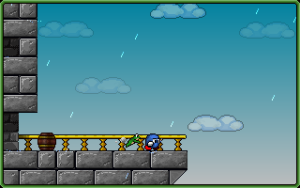
Unfortunately for Spud’s Quest, many of the adventure game elements just aren’t very fun. The biggest offender here by far is the inventory limit. This was an issue I had with Mystik Belle, another recent game which blends the adventure and platformer genres, but it is much worse here. Not only can you only carry four items at a time, but many of these items are useless red herrings which presumably exist purely because it was something which the Dizzy games did. Warp points do exist and the game is, with a few exceptions, good about placing items in the same general region as the problem which they resolve, but you will still inevitably waste a significant amount of time backtracking and swapping around items without a guide. Taking another questionable note from the Dizzy series, there are absolutely no item descriptions and NPC’s only ever react to an item if it is the one they need. The number of NPC’s in Spud’s Quest is high enough that I wouldn’t expect every character to have a unique reaction to every single one of the dozens of items, but at least some potential clues from additional dialogue or item descriptions would have been nice to have in a game where solutions as completely unintuitive as giving sleeping pills to a giant octopus exist.
 The issues with the adventure game elements extend to beyond inventory management and unintuitive puzzles. For example, the day and night system is a bit of a mixed bag. On the one hand, the world feels surprisingly alive as many NPC’s will change their locations and what do and say over the course of the day, shops and homes will open and close, and even many enemy locations will alter. The aesthetics which go along with this cycle are also impressive as time constantly, visibly moves forward; the sun and moon gradually shift across the sky, fireflies appear when night starts to fall, lights appear in doors and windows, and there’s even a rain cycle which seems to be purely aesthetic. However, this system comes with two downsides. First, the only way to move time forward more quickly is to rest in a bed, but you can only choose to rest until nightfall or morning and several doors only open in the middle of the day, forcing you to still wait around if you need something from the house in question. Secondly, interacting with a bed will tell you how much time is left until morning or nightfall, but it would have been better to have simply been given a clock in the UI or even in one of the menus. A bigger issue comes in the form of the dialogue. From a technical standpoint the dialogue can be buggy at times and, though it never broke the game or prevented progress, in my playthrough I had a witch NPC tell me she would make me a potion long after she had already made it and at one point the handful of helper NPC who point you towards your next major objective insisted on telling me to search a town for an item I already had. For a game with such a colorful, cheerful-looking world, there are not all that many good jokes. In fact, a disturbing number of the characters you come across are outright gloomy or mean-spirited and include disgruntled, overworked miners, a poor farming couple whom have had their farm vandalized by local children, and even a depressed, alcoholic lumberjack. Sometimes Spud and Prince Charming need to help NPC’s in their journey to collect the elemental essences, but just as often these characters exist purely to add ‘flavor’ to the world and, in some cases, our protagonists actually make things worse for the sake of progressing their quest.
The issues with the adventure game elements extend to beyond inventory management and unintuitive puzzles. For example, the day and night system is a bit of a mixed bag. On the one hand, the world feels surprisingly alive as many NPC’s will change their locations and what do and say over the course of the day, shops and homes will open and close, and even many enemy locations will alter. The aesthetics which go along with this cycle are also impressive as time constantly, visibly moves forward; the sun and moon gradually shift across the sky, fireflies appear when night starts to fall, lights appear in doors and windows, and there’s even a rain cycle which seems to be purely aesthetic. However, this system comes with two downsides. First, the only way to move time forward more quickly is to rest in a bed, but you can only choose to rest until nightfall or morning and several doors only open in the middle of the day, forcing you to still wait around if you need something from the house in question. Secondly, interacting with a bed will tell you how much time is left until morning or nightfall, but it would have been better to have simply been given a clock in the UI or even in one of the menus. A bigger issue comes in the form of the dialogue. From a technical standpoint the dialogue can be buggy at times and, though it never broke the game or prevented progress, in my playthrough I had a witch NPC tell me she would make me a potion long after she had already made it and at one point the handful of helper NPC who point you towards your next major objective insisted on telling me to search a town for an item I already had. For a game with such a colorful, cheerful-looking world, there are not all that many good jokes. In fact, a disturbing number of the characters you come across are outright gloomy or mean-spirited and include disgruntled, overworked miners, a poor farming couple whom have had their farm vandalized by local children, and even a depressed, alcoholic lumberjack. Sometimes Spud and Prince Charming need to help NPC’s in their journey to collect the elemental essences, but just as often these characters exist purely to add ‘flavor’ to the world and, in some cases, our protagonists actually make things worse for the sake of progressing their quest.
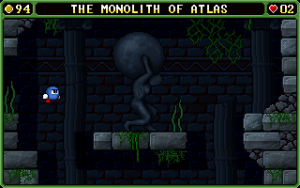
Thankfully, the platforming goes a long way towards making up for the shortcomings of the adventure elements. Spud starts off only able to jump and toss red rocks at enemies, but he gains a few other tricks along the way, the first, and most important, one being the ability to push certain blocks and carry smaller ones. There are ten health upgrades to find scattered throughout the temples and the overworld as well as fifty ‘trinkets’, which are often hidden behind cracked, breakable walls or in out of the way areas which can require some creative thinking and carefully platforming to reach. Controller can also be swapped over to Prince Charming who, as a frog, can enter into smaller areas to push switches and pull levers. Prince Charming cannot pick up or use items, but he only teleports back to Spud without taking any damage when he is hit so he is useful for scouting out potential hazards. The only issue with the character swap mechanic is there is no quick way to recall Prince Charming back to Spud if they are far apart so I frequently had to either perform multiple screen transitions or make Prince Charming take a hit to have him teleport back to Spud. As the overworld is primarily focused on the more adventure game side of things, there are sadly only a handful of times in which using Prince Charming or manipulating blocks is required outside of the temples.
I may not be particularly fond of many things about the overworld segments of Spud’s Quest, but I do think the temples are consistently fun and clever and I would have given this game a much stronger recommendation had a larger portion of its playtime been devotes to these areas. Like the rest of the game, temples are divided into many single-screen rooms, each with its own name. The perspective may be different and there may not be any boss fights beyond the final boss, but the Zelda influence is easily felt in this branching, puzzle-filled dungeons. One of the biggest issues in the overworld, inventory management, is largely absent from temples as, with a small exception in the fourth temple, you never need to use any items within a temple other than those found inside it. Though they still exist, red herrings are much rarer inside temples than in the outside world and there is almost never a point at which you need to worry about juggling more items than your limited inventory can hold while in a temple.
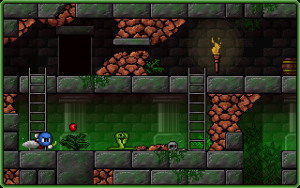
One of the best things about these temples is how distinctive they each feel. It may not make a whole lot of sense as far as the fairytale setting goes, but there is a bit of a La-Mulana feel to these temples as each contains various statues, murals, and other works of art depicting mythological figures from different cultures. The hazards, enemies, and puzzles found in each temple also generally are based on the elemental essence in question, such as a room in which Spud must avoid meeting the petrifying gaze of Medusa in the earth temple. Obtaining an elemental essence may be the ultimate goal of each temple, but the main task which must be completed in order to obtain an essence changes significantly between temples. For example, the surprisingly vertical water temple requires Spud to find wooden cogs which, when placed in a machine, each raise the water level to grant access to a higher floor while the goal of the ice temple is to find four keys to free kidnapped children and then safely carry them back to the entrance (a process which is, unfortunately, the cause of a rather serious oversight as these children teleport to the start of the current room if they get hit by anything and this teleport can glitch them into a wall, which can require reloading a save to fix).
The puzzle-based platforming elements of each temple are easily the best parts of the entire game. Most enemies and hazards only deal a small amount of damage, but the only ways to heal in Spud’s Quest are to either find a health upgrade or to pay gold (which is obtainable in small amounts from enemies and in somewhat larger quantities from giving books and flowers to certain NPC’s) to a healer outside each dungeon so there is a real sense of risk to rushing ahead which makes scouting with Prince Charming particularly useful in these areas. As little use as Prince Charming gets outside of temples, he is frequently needed within them to slip through small openings and press switches to open doors for Spud or, in later areas, to flip switches which toggle red and blue blocks on and off. Prince Charming is not able to climb ladders or cling to vines, but he can land on top of Spud’s head, using Spud as a platform to reach areas which would otherwise be out of reach. A good number of puzzles also require Spud and Prince Charming to open a door by standing on two switches simultaneously, which often requires a good bit of planning as, in addition to being incapable of climbing, Prince Charming will not remain still when not under the player’s control, meaning Spud must first be positioned on his switch and Prince Charming must then reach his without Spud’s assistance.
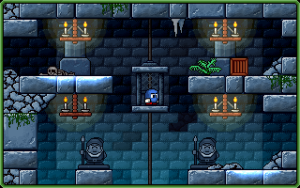
Other than puzzles which require players to coordinate Spud and Prince Charming, many puzzles involve block manipulation. Sometimes, these puzzles simply involve examining an area to look for cracked blocks to break or brightly-shaded blocks to push. At other times, players must figure out ways to push and stack combinations of blocks to be able to reach new areas. As large blocks can only be pushed along the ground and Spud’s jump height is severely reduced while he is carrying a small block above his head these puzzles usually involve figuring out a way to overcome these limitations and frequently involve manipulating objects in several different rooms. Many of these block puzzles are particularly enjoyable because they often involve some out of the box thinking and demand players to come up with multiple uses for a single item. For example, an early puzzle in the ice temple involves a large wooden box on some ice; there is an opening above the center of the icy room, but pushing the box immediately sends it flying to the other side. In this situation, the solution was to realize that a small block used as a platform in the previous room could be tosses onto the ice to stop the box below the opening. Temple puzzles are rarely unintuitive or even complex, but they are great at hiding simple solutions in plain sight, leading to a good number of immensely satisfying ‘aha!’ moments as you realize you had been staring at the solution all along.
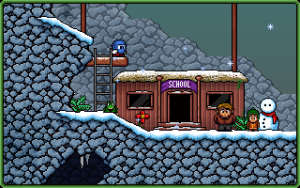
The amount of time Spud’s Quest devotes to its item-oriented overworld and its dungeons focused more upon puzzle platforming is split fairly evenly, but these two segments of the gameplay feel so dramatically different from each other that I want to emphasize that I would only recommend this game to those who either like both segments or, as in my case, greatly enjoy one and can at least tolerate the other. I am not particularly fond of this game’s sense of humor, nor of its dialogue in general, I rarely approve of limited inventory space, especially in regards to key items, and I found several of the later item-oriented puzzles to be completely unintuitive. However, many of the elements of this game which I find disagreeable are ones which are also present in the Dizzy series, so those with fond, nostalgic memories for that series may very well find the adventure game parts of Spud’s Quest to their liking. As it stands, I recommend this game primarily for its great dungeons and would suggest others to not shy away from using a guide for those moments when you just can’t figure out what to do with sleeping pills, a newspaper, and a red herring.